The AMD Radeon R9 Nano Review: The Power of Size
by Ryan Smith on September 10, 2015 8:00 AM ESTCompute
Shifting gears, we have our look at compute performance.
Starting us off for our look at compute is LuxMark3.0, the latest version of the official benchmark of LuxRender 2.0. LuxRender’s GPU-accelerated rendering mode is an OpenCL based ray tracer that forms a part of the larger LuxRender suite. Ray tracing has become a stronghold for GPUs in recent years as ray tracing maps well to GPU pipelines, allowing artists to render scenes much more quickly than with CPUs alone.
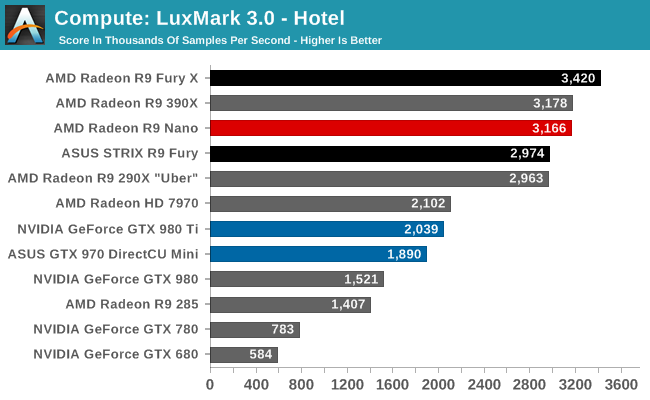
LuxMark ends up being a great corner case for where having a fully enabled Fiji GPU is more important than having the highest clockspeeds. With the R9 Nano able to flirt with its full 1000MHz clockspeed here, the card is able to pass the R9 Fury here. The only thing stopping it from taking the second-place spot is the R9 390X, as Hawaii still sees strong performance here even with fewer SPs.
For our second set of compute benchmarks we have CompuBench 1.5, the successor to CLBenchmark. CompuBench offers a wide array of different practical compute workloads, and we’ve decided to focus on face detection, optical flow modeling, and particle simulations.
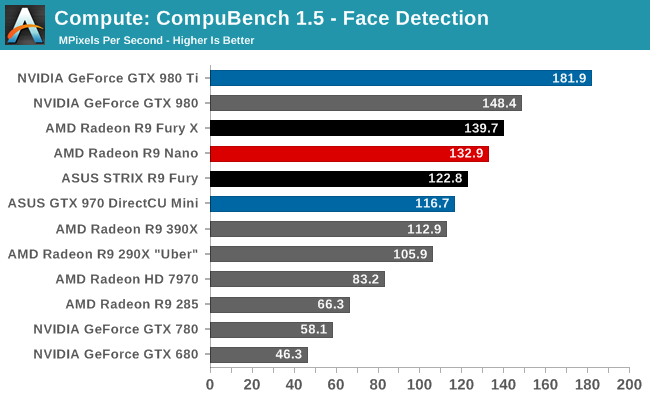
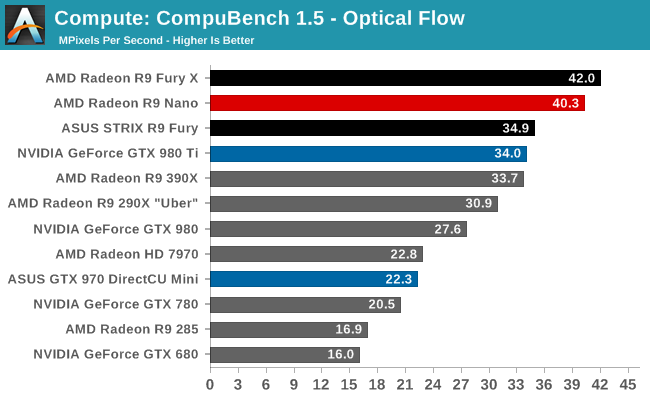
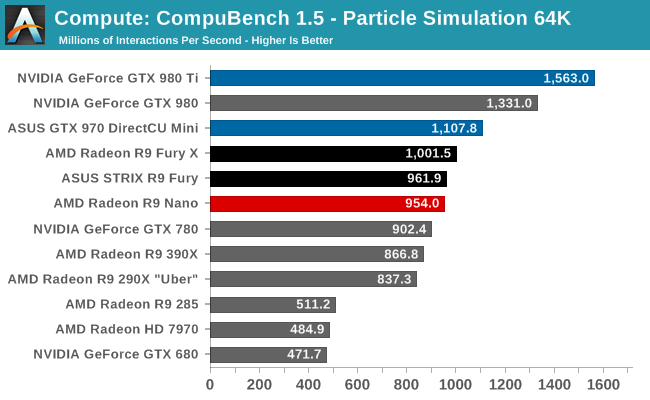
CompuBench provides us another case of where the R9 Nano ends up outpacing the R9 Fury. As a result AMD’s latest card tends to perform somewhere between an R9 Fury and R9 Fury X, with all of the strengths and weaknesses that come from that. This puts the R9 Nano in a good place for Optical Flow, while it will still trail NVIDIA”s best cards under Face Detection and the 64K particle simulation.
Meanwhile it’s interesting to note that AMD’s particle sim scores have significantly improved in the recent drivers. GCN 1.2 cards have seen 20%+ performance improvements here, which may point to some new OpenCL compiler optimizations from AMD.
Our 3rd compute benchmark is Sony Vegas Pro 13, an OpenGL and OpenCL video editing and authoring package. Vegas can use GPUs in a few different ways, the primary uses being to accelerate the video effects and compositing process itself, and in the video encoding step. With video encoding being increasingly offloaded to dedicated DSPs these days we’re focusing on the editing and compositing process, rendering to a low CPU overhead format (XDCAM EX). This specific test comes from Sony, and measures how long it takes to render a video.
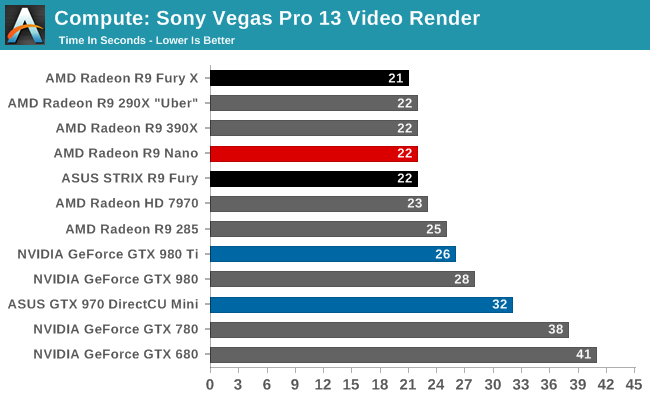
With Vegas there are no surprises; the R9 Nano ties the R9 Fury.
Moving on, our 4th compute benchmark is FAHBench, the official Folding @ Home benchmark. Folding @ Home is the popular Stanford-backed research and distributed computing initiative that has work distributed to millions of volunteer computers over the internet, each of which is responsible for a tiny slice of a protein folding simulation. FAHBench can test both single precision and double precision floating point performance, with single precision being the most useful metric for most consumer cards due to their low double precision performance. Each precision has two modes, explicit and implicit, the difference being whether water atoms are included in the simulation, which adds quite a bit of work and overhead. This is another OpenCL test, utilizing the OpenCL path for FAHCore 17.



Much like CompuBench and LuxMark, the R9 Nano punches above its weight here. The lack of a graphics workload – and resulting demands on graphics hardware like the ROPs – means most of the card’s power can be allocated to the shaders, allowing higher clockspeeds. This gives the Nano a boost in this situation to bring it much closer to the Fury X, though as far as Folding goes AMD will still trail NVIDIA’s best cards.
Wrapping things up, our final compute benchmark is an in-house project developed by our very own Dr. Ian Cutress. SystemCompute is our first C++ AMP benchmark, utilizing Microsoft’s simple C++ extensions to allow the easy use of GPU computing in C++ programs. SystemCompute in turn is a collection of benchmarks for several different fundamental compute algorithms, with the final score represented in points. DirectCompute is the compute backend for C++ AMP on Windows, so this forms our other DirectCompute test.

Our final test sees the R9 Nano brought back to its place behind the R9 Fury, as the C++ AMP sub-tests are strenuous enough to cause more significant clockspeed throttling. Even behind the R9 Fury the R9 Nano does well for itself here, coming in behind the GTX 980 Ti and head of the R9 390X and GTX 980.










284 Comments
View All Comments
gw74 - Friday, September 11, 2015 - link
Everything you say here is refuted by my previous comment.slickr - Saturday, September 12, 2015 - link
LOL. Either you are one of the biggest dumbasses out there or a shill yourself. To believe it was a "honest mistake" is like believing the earth is made out of cheese.They had at least 2 months to fix it and to rectify it, did they not read any of the hundred of reviews? They tried to cover it up and it was only when average CONSUMERS started noticing it and testing it that it was found out it had been a major fraud.
gw74 - Saturday, September 12, 2015 - link
insulting me, setting up a false dichotomy and a false analogy will not help you.They did not realise there had been an error during those 2 months, and none of the reviews mentioned it, because it does not noticeably affect performance except in certain SLI / 4K low framerate edge cases. It was only when until users starting reporting it in mid Jan. They had meetings between marketing and engineering then released a statement to PCPer on 24th Jan.
Oxford Guy - Tuesday, September 15, 2015 - link
Nvidia continued to lie to the public on its website by stating that the 970 has 224 GB/s, long after Anandtech's Correcting the Specs article was published — which made it clear enough that the card can't reach that number. Quit shilling.Alexvrb - Saturday, September 12, 2015 - link
Err, uh, the engineers only communicate in binary! The translator was sick that week! Locusts! It wasn't their fault!!Reality: "Well technically it has 4GB on there so we'll just... leave that detail out... they won't notice for months anyway. Then we'll apologize and a bunch of fanboys will defend us till the bitter end anyway."
If AMD had pulled a stunt like that they would have been raked through the coals till there were only ashes.
gw74 - Saturday, September 12, 2015 - link
no. that is not "reality". That is speculation.bigboxes - Thursday, September 10, 2015 - link
Utter nonsense. Nvidia knew damn well that they had a technical and marketing issue and lied through their teeth. Misleading reviewers, customers and the general tech community. It eventually came out and they went into full damage control. And before you say it, I bought an MSI GTX 970 Gaming 4G card after all this went down. I'm happy with this card, but it is what it is.gw74 - Friday, September 11, 2015 - link
you forgot to include evidence of them lying, or a reason for why they would lie.Oxford Guy - Friday, September 11, 2015 - link
It's called reality, dude.gw74 - Friday, September 11, 2015 - link
meaningless